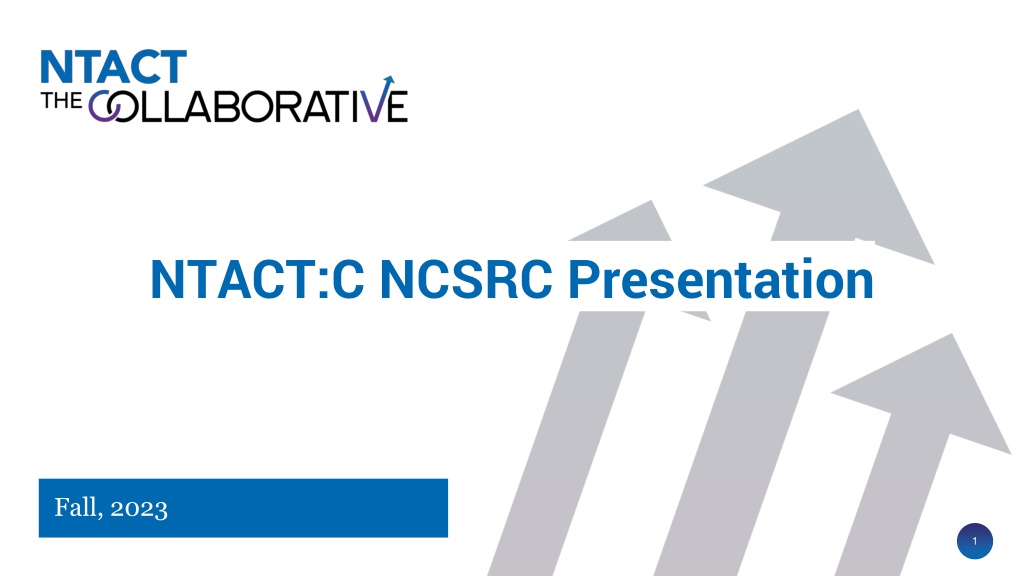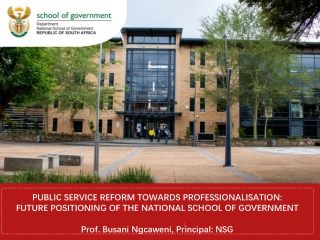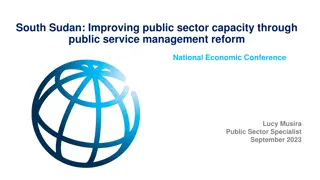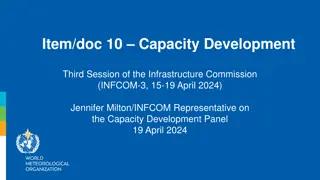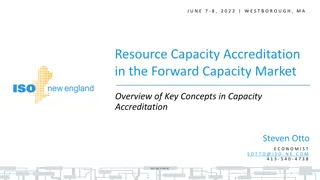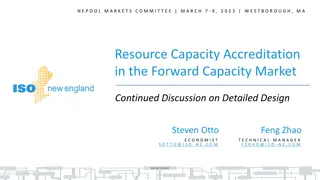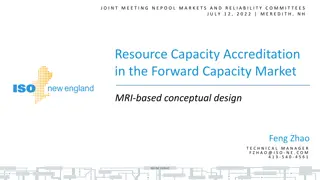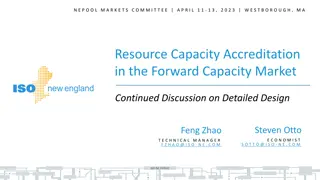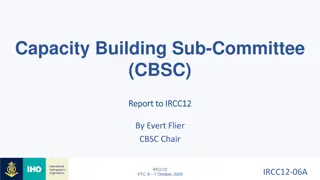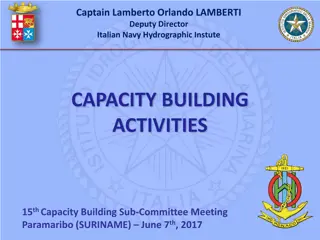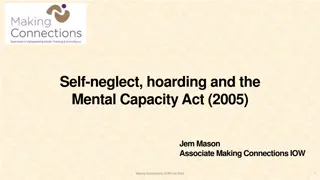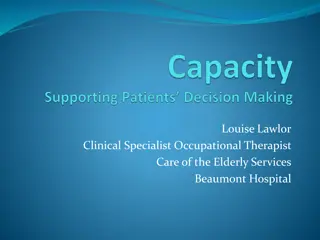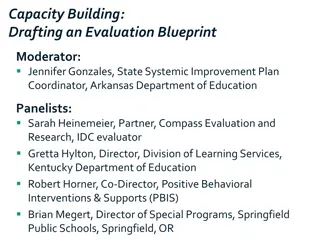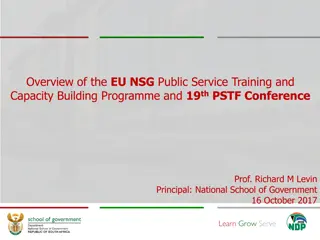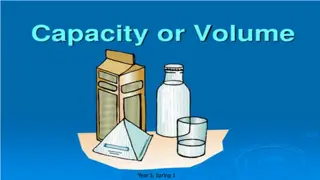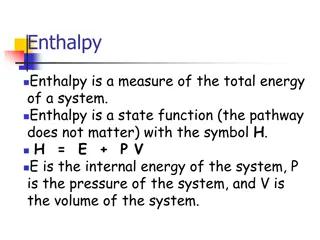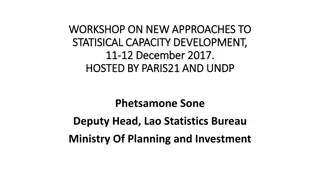Enhancing State Capacity Building in Education
Co-funded by OSEP and RSA, NTACT:C.NCSRC focuses on providing intensive technical assistance to states while engaging in strategic planning and action steps. With a wide range of resources and tools, virtual and in-person trainings, the center supports effective practices, data analysis, collaborative technical assistance systems, and quality professional development to improve interagency collaboration and overall state capacity in education.
Download Presentation

Please find below an Image/Link to download the presentation.
The content on the website is provided AS IS for your information and personal use only. It may not be sold, licensed, or shared on other websites without obtaining consent from the author.If you encounter any issues during the download, it is possible that the publisher has removed the file from their server.
You are allowed to download the files provided on this website for personal or commercial use, subject to the condition that they are used lawfully. All files are the property of their respective owners.
The content on the website is provided AS IS for your information and personal use only. It may not be sold, licensed, or shared on other websites without obtaining consent from the author.
E N D
Presentation Transcript
NTACT:C NCSRC Presentation Fall, 2023 1
Who We Are Who We Are Co-Funded by OSEP and RSA Our Partners: University of North Carolina at Charlotte East Tennessee State University The George Washington University Portland State University University of Kansas University of Maryland University of Oregon 2
What We Do What We Do Resources and tools Virtual and in-person trainings Support state agency strategic planning Support state agency action steps 4
Our Centers Work At a Glance Our Center s Work At a Glance 18 States receiving Intensive Technical Assistance Almost every state and territory engaged in Targeted or Universal TA Our Website: 16,638 User Total Accounts - all 50 states + American Samoa, Puerto Rico, Northern Mariana Islands, Virgin Islands, Federated States of Micronesia, Guam 108 with BIE/Tribal Entity 33 webinars and 6725 people enrolled across all 499 documents; 464 have been downloaded 5
Building Building State State Capacity Capacity 6
Building State Capacity Building State Capacity Knowledge of Effective Practices Data Analysis and Use Collaborative Technical Assistance Systems Quality Professional Development 7
The Capacity Building Institute Model 8
Capacity building model to improve interagency Capacity building model to improve interagency collaboration collaboration Institute is ONE ONE piece of NTACT:C s capacity building model ONGOING ONGOING process Strategic planning occurs ALL YEAR ALL YEAR Access NTACT:C support and TA WHEN NEEDED WHEN NEEDED 9
Highlights from the NTACT:C CBI Highlights from the NTACT:C CBI May 16 May 16- -18, 2023 18, 2023 Back together to build together in Charlotte, NC 17thCBI and 3rdCBI hosted by the NTACT:C Focus on youth voice and leadership throughout 443 participants 47 states and entities participated 42 interagency state teams engaged in strategic planning 10
State Teams State Teams 44 States, Territories, or Jurisdictions are attending the CBI with a team Largest team - 20 Smallest team(s) - 1 Average team size - 7.8 Furthest team - Federated States of Micronesia & Northern Mariana Islands 11
Vocational Rehabilitation and Special Education State Vocational Rehabilitation and Special Education State personnel on Team personnel on Team 39 States have both VR and SpEd State Personnel on Team 12
States with a Family Member or Parent Training & States with a Family Member or Parent Training & Information Center Information Center 20 States have a family member or a Parent Training & Information Center representative on their team 13
Youth, YETI, Youth Advocates on State Teams Youth, YETI, Youth Advocates on State Teams 10 states have a youth, YETI member, or youth advocate on their team 14
State Career & Technical Education Personnel on Team State Career & Technical Education Personnel on Team 12 States have CTE State Personnel represented on their team 15
State Team Plan Goals State Team Plan Goals Interagency Collaboration Interagency Collaboration: : Cross-Agency Professional Development & Coordinated Service Delivery ( included in 20 state plans) Youth Engagement Youth Engagement (included in 6 state plans) Family Engagement Family Engagement (included in 8 state plans) Engagement in CTE and/ or Pre Engagement in CTE and/ or Pre- -ETS ETS (included in 7 state plans) Data Sharing Data Sharing (included in 10 state plans) 16
NTACT:C Engagement throughout the Year NTACT:C Engagement throughout the Year Website: www.transitionta.org Webinars, resources, FAQs, Presenter guides, videos, documents, toolkits, data resources, etc. Communities of Practice (Blind Pre-ETS, Students with Complex Support Needs) Pre-ETS Office Hours State Sharing events (online or in-person) Peer Networks TA Agreements with state ed. and/or VR agency personnel focused on transition Interagency Agreement, , Policy and Service provision, Forecasting, Data Collection/ Use, Effective Practice(s), Sequencing Services 17
VR Focused Technical VR Focused Technical Assistance Assistance 18
VR Program Provides a Continuum of Services VR Program Provides a Continuum of Services earliest set of services for potentially eligible or eligible students with disabilities (swd) short term in nature to help identify career interests specific set of five required activities provided directly to swd under Pre-ETS States must reserve a minimum of 15% of federal funds to provide Pre-ETS services Pre-ETS Services available for eligible students or youth with disabilities through an Individualized Plan for Employment (IPE) help further develop and pursue career interests through post-secondary ed, vocational training, job search, job placement, job retention, job follow-up and job follow-along services Transition Services typically provided once eligible students or youth with disabilities have further identified, developed and pursued career interests, offered through transition services, and are pursuing specific employment outcomes through an IPE assist in preparing for, securing, retaining, advancing in or regaining an employment outcome Employment Related 19
VR Transition Services Individualized Transition Services Pre-Employment Transition Services Group Transition Services (34 CFR 361.49(a)(7)) (34 CFR 361.48(b)(18)) (34 CFR 361.48(a)) Only for students with disabilities in a recognized educational program For groups of students and youth with disabilities For students and youth with disabilities VR application and IPE are not required VR application and approved IPE are required VR application and IPE are not required Services are not individualized but benefit a group. Participation in the VR program is not required. Services may include group tours, employer visits, career fairs, etc. Any allowable VR service, including pre-employment transition services, can be provided, such as job coaching, job placement, transportation, etc., under an IPE The 5 required Pre-ETS services can be provided in a group setting or individually. 20
21 Pre Pre- -Employment Transition Services (Pre Employment Transition Services (Pre- -ETS) ETS) Earlier Age In More Students Collaboration with Education Pre- Employment Transition Services High Quality Employment Outcomes More Services 21
Job Exploration Counseling Gain information about career pathways and uncover personal career interests The 5 Required Pre The 5 Required Pre- - ETS Activities ETS Activities Assessment Assessment The On The On- -Ramp or The Ramp or The Appetizer Appetizer Instruction in Self- Advocacy Learn how disability may impact employment and how to self advocate in the workplace Workplace Based Learning Practice skills in the workplace Counseling on opportunities for post-secondary training at IHE Learn about educational programs at colleges and universities Workplace Readiness Training Understand what it takes to get and keep a job 22
Pre Pre- -Employment Employment Transition Services Transition Services The National Landscape almost a decade later 23
Guam, Northern Marianas, and the Virgin Islands reserved and expended 0 percent. 24
Students with Disabilities (SWD) - PY 17 through PY 21 First to Last Year Comparisons PY 2017 PY 2018 PY 2019 PY 2020 PY 2021 % Change # Change Number of SWD Reported 525,958 638,601 682,237 622,498 663,901 26% 137,943 Number of SWD Received a Pre-ETS 179,716 248,336 247,926 203,638 250,784 40% 71,068 Percent of SWD Reported Who Received a Pre-ETS 34% 39% 36% 33% 38% 3.6% Number of Potentially Eligible SWD Who Received a Pre-ETS 85,245 137,780 144,346 102,495 137,807 62% 52,562 Number of SWD, who Applied and Received a Pre-ETS 94,471 110,556 103,580 101,143 112,977 20% 18,506 Percent of SWD, who Applied and Received a Pre-ETS 53% 45% 42% 50% 45% -8% Total Pre-ETS Provided 747,837 1,227,841 1,349,877 1,171,303 1,555,903 108% 808,066 VR Process - PY 17 through PY 21 First to Last Year Comparisons % Change # Change -26% (123,696) PY 2017 473,609 PY 2018 447,282 PY 2019 361,684 PY 2020 296,009 PY 2021 349,913 25 Applicants
Coordination and Collaboration Coordination and Collaboration with Education: with Education: We re All In It Together 26
Coordination Identified in the Regulations Coordination Identified in the Regulations 34 CFR 361.22 Coordination with education officials (a)(1) - The VR portion of the State Plan must contain plans, policies, and procedures for coordination between VR and ED. 34 CFR 361.22(a)(2) Must provide for the development and approval of an IPE as early as possible during the transition planning process and not later than the time a student with a disability determined to be eligible for vocational rehabilitation services leaves the school setting or, if the designated State unit is operating under an order of selection, before each eligible student with a disability able to be served under the order leaves the school setting. 34 CFR 361.22(b) Formal interagency agreement - The State Plan must include information on a formal interagency agreement with the State educational agency. 34 CFR 361.45(d)(9)- An IPE for a student with a disability is developed in consideration of the student s IEP or 504 services. 34 CFR 361.46 (d) Coordination of services for students with disabilities the IPE must be coordinated with the IEP or 504 services. 34 CFR 361.48(a)(4))) Pre-employment transition services coordination activities including: Attending IEP meetings and Working with schools to coordinate and ensure the provision of pre-employment transition services 27
Coordination Requirements Coordination Requirements Changed the Landscape for Changed the Landscape for Both Education and VR Both Education and VR 28
Collaboration in the Provision of Pre-ETS 34 CFR 361.5(c)(51) - Each State must ensure that the designated State unit, in collaboration with the local educational agencies involved, provide, or arrange for the provision of, pre-employment transition services for all students with disabilities, as defined in 361.5(c)(51), in need of such services, without regard to the type of disability (361.48(a)) 29
Collaboration with Local Education Agencies Collaboration with Local Education Agencies The regulations redefined the meaning of collaboration between VR and education, and now, more than ever effective communication and building strong relationships are key to the successful delivery of not just Pre-ETS services, but all transition services. LEAs are obligated to provide transition services under the Individuals with Disabilities Education Act (IDEA) LEAs are responsible for providing and paying for any transition service that is considered special education or related services necessary for ensuring a free appropriate public education (FAPE), as required under IDEA. Nothing under Title I of the Rehabilitation Act shall be construed as reducing a LEA s obligation to provide the above-described services under IDEA (see Section 101(c) of the Rehabilitation Act and 34 C.F.R. 361.22(c) of the VR regulations). Pre-employment transition services provided by VR agencies may not duplicate services that are already provided by local education agencies through the IDEA Decisions as to who will be responsible for providing services that are both special education services and vocational rehabilitation services must be made at the State and/or local level as part of this collaborative process, and will be further defined in the formal interagency agreement. 30
Guiding Questions to Help Determine Who Pays Guiding Questions to Help Determine Who Pays and/or Provides for the Service and/or Provides for the Service Who Benefits Who Benefits Intentionality Intentionality What is the intentionality of it (this is how RSA What is the intentionality of it (this is how RSA views harm to the federal interest)? views harm to the federal interest)? Who is going to benefit from the service being provided? If you are using VR resources (staff and or funds), can you ensure that only VR recipients are benefitting from those funds? So you will need to make decisions at both the state and local level about whether the service: is related to an employment outcome or educational attainment, or if it is considered a special education or related service, as well as whether the service is one customarily provided under IDEA or the Rehabilitation Act Have you clearly outlined the procedures to delineate what is a VR service from a service under IDEA, and have you provided staff guidance on how to make that determination at the local level? 31
Strategies to Reduce Duplication of Services Strategies to Reduce Duplication of Services The following are suggested steps that schools and VR can take to plan for how Pre-ETS can be provided to all students that need them: Review the student s class schedule with school personnel and identify any overlap with the provision of any of the five required Pre-ETS activities. Discuss specific activities within the five required Pre-ETS, that are not currently available to all students with disabilities at the school or might need to be strengthened based on student need and fill those gaps. Review the provision of Pre-ETS to students on a regular basis, make changes as needed, and share this information with the school. Review student progress and student outcomes for each of the five required Pre-ETS to determine if the student continues to need Pre-ETS, and/or how the continuum of VR services could support the provision of additional VR transition services, and support IEP team planning. 32
Example - Work Work- -Based Learning Crosswalk Based Learning Crosswalk School School- -Level Transition Services Level Transition Services (IDEA, 2004) Facilitated by School Facilitated by School- -Level Practitioners Pre Pre- -Employment Transition Services Employment Transition Services (Rehabilitation Act, as amended by Title IV of WIOA, 2014) Provided and/or Arranged by VR Personnel Provided and/or Arranged by VR Personnel Level Practitioners Provide transportation for job shadowing activities Provide teacher s aid or other support services personnel if needed for work experience rotations Provide school-based work preparation (e.g., mock interviews, resume writing, job applications, school-based enterprises) Recruit business mentors Provide students paid work experiences Coordinate Informational Interviews Create internships within career pathways Coordinate job shadowing events Provide opportunities for worksite tours 33
34 Side-by-Side Transition Services
Outcomes are largely contingent upon what you do at the Outcomes are largely contingent upon what you do at the very beginning... very beginning... The foundation of the VR program is the principle that individuals with disabilities, including those with the most significant disabilities, are capable of achieving high quality, competitive, integrated employment when provided the necessary services and supports. Developing and strengthening collaborative partnerships results in a coordinated plan of service delivery to support students in achieving meaningful post-secondary employment and training outcomes. 35
What is the Impact of Successful Coordination and What is the Impact of Successful Coordination and Collaboration for Our Students? Collaboration for Our Students? Student Progress and Outcomes Family and Student Engagement Informed Decision Making 36
When students succeed, we do, too! Students Education High school diploma Vocational Rehabilitation Career pathways with multiple on/off ramps Students actively engaged, staying in school, and graduating Increased involvement with students at younger age Students apply for VR services earlier Students identify IPE employment goal Increased competitive, integrated employment Higher wages and long-term employment success WIOA common performance measures increase Employment or training in higher skilled jobs Students achieve IEP post- secondary goals Practice employability skills Increased partnerships & support Post-school training/education Successful post-school outcomes Self-determination and self-advocacy IDEA transition indicators improve 37
Announcements Announcements and and 2024 CBI Save 2024 CBI Save- -the the- -Date! Date!
NTACT:C 2024 Capacity Building Institute NTACT:C 2024 Capacity Building Institute Embracing collective growth now, let s dig in! May 7 May 7- -9 9 Hilton Charlotte University Place (renovated!) 8629 JM Keynes Drive, Charlotte, NC 28262 The NTACT:C 2024 CBI will feature: In-person only format for state team delegates (up to 8) CBI content reflecting the resource and TA requests received throughout the year Support for year round interagency team engagement More details and registration coming soon! 39
Thank You Thank You Maureen McGuire-Kuletz, Ed.D, CRC Co-Director/Associate Professor The GW Center for Rehabilitation Counseling, Research and Education Email: mkuletz@gwu.edu http://www.gwcrcre.org Melissa Diehl, MA. ED., CRC Senior Technical Assistance and Research Analyst National Technical Assistance Center on Transition: The Collaborative (NTACT:C) The George Washington University Email: mpdiehl@gwu.edu 40
Find us on: Find us on: #transitionTA | transitionTA.org | ntactmail@uncc.edu The contents of this presentation were developed under a grant (H326E200003) from the Department of Education. However, those contents do not necessarily represent the policy of the Department of Education, and you should not assume endorsement by the Federal Government. 41
